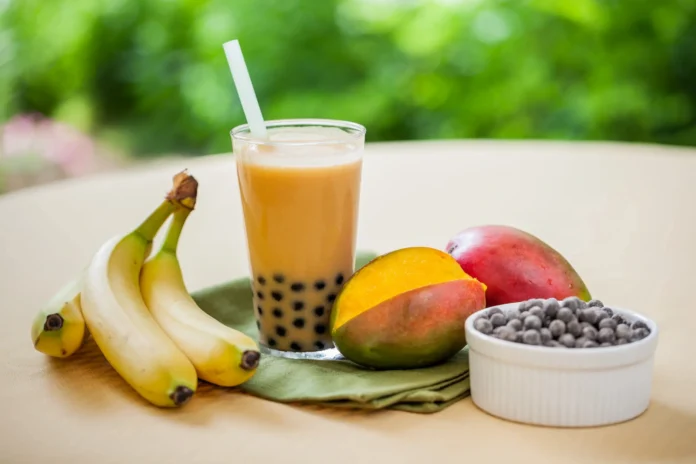Boba, a commonly known name of Bubble Tea, has overtaken the world over the past few decades. Originating in Taiwan in the 1980s, this unique beverage has captured the hearts of millions globally, transforming from a local delicacy into an international sensation. But what exactly it is, and why has it become so popular? This article delves into the rich history, diverse varieties, and cultural significance of this drink, offering readers a comprehensive understanding of this beloved drink.
The Origins of Boba
The story of this drink begins in Taiwan, where tea drinking has been a cultural tradition for centuries. In the early 1980s, as Taiwan’s economy grew, so did the demand for innovative food and drink options. Two tea shops, Chun Shui Tang in Taichung and Hanlin Tea Room in Tainan, are often credited with inventing bubble tea. Chun Shui Tang claims to have created the drink by adding sweetened tapioca pearls to cold tea, while Hanlin Tea Room’s version involved using white tapioca balls, which later evolved into the black pearls we know today.
What is Boba?
At its core, this is a tea-based drink that typically includes chewy tapioca pearls, also known as “boba” or “pearls.” The drink can be served hot or cold, with a variety of flavours and toppings available. The tapioca pearls, made from cassava starch, are cooked until they reach a chewy, gummy consistency. These pearls are then added to the tea, which is usually sweetened and flavored with ingredients like fruit, milk, or syrup.
Types of Boba Drinks
Over the years, it has evolved into numerous variations, catering to diverse tastes and preferences. Below is a table summarizing some of the most popular types of these drinks:
| Type of Boba Drink | Description |
| Classic Milk Tea | A blend of black tea, milk, and boba pearls. |
| Fruit Tea | Tea infused with fruit flavors, often with fruit chunks and boba pearls. |
| Slush or Smoothie | A blended, icy version of boba with fruit or milk flavors. |
| Brown Sugar Milk | A drink featuring boba pearls cooked in brown sugar syrup, mixed with milk. |
| Matcha | A green tea variant made with matcha powder, often combined with milk. |
| Taro Milk Tea | A purple-coloured drink made with taro root, offering a sweet, nutty flavour. |
The Cultural Impact
The drink’s appeal extends beyond its unique taste and texture; it has also become a cultural phenomenon. In many Asian countries, its shops are social hubs where people gather to chat, study, or relax. The drink’s popularity has also spread to the West, particularly in the United States, where its shops have become a staple in many urban areas.
In addition to its role as a social drink, it has become a symbol of Asian-American identity, particularly among younger generations. For many, it represents a connection to their cultural heritage, while also serving as a marker of modern, globalized culture. This dual significance has contributed to the drink’s enduring popularity and its expansion into mainstream culture.
The Business of Boba
The tea industry has grown exponentially since its inception, with new shops opening regularly in cities worldwide. The global bubble tea market was valued at over $2 billion in 2020 and is projected to continue growing at a rapid pace. This growth is fueled by the drink’s popularity among young consumers, who are drawn to its customizable nature and the wide range of flavors available.
In response to this demand, many entrepreneurs have capitalized on the drink trend by opening speciality shops and offering unique twists on the classic drink. Some have even created hybrid versions, combining this drink with other popular drinks like coffee or alcoholic beverages. Its versatility has made it a favorite among food and beverage innovators, further driving its global appeal.
Health Considerations
While it is undoubtedly delicious, it is also important to consider its nutritional content. The tapioca pearls are primarily composed of carbohydrates, and when combined with sweetened tea and milk, the drink can be quite high in calories and sugar. Here is a breakdown of the typical nutritional content of a standard 16-ounce serving of classic milk tea with the drink:
| Nutrient | Amount per Serving (16 oz) |
| Calories | 300-400 kcal |
| Sugar | 30-50 g |
| Carbohydrates | 50-70 g |
| Fat | 5-10 g |
| Protein | 2-4 g |
Given these values, it is advisable to consume the drink in moderation, especially for those monitoring their sugar intake. Some shops offer healthier alternatives, such as using less sugar or opting for non-dairy milk options, to cater to health-conscious customers.
Promising Future
As this drink continues to gain popularity, its future seems promising. Innovations in flavours, ingredients, and preparation methods are constantly emerging, ensuring that it remains a dynamic and evolving drink. The rise of social media has also played a significant role in spreading its culture, with Instagram and TikTok serving as platforms for its enthusiasts to share their creations and experiences.
In addition, the sustainability movement is beginning to influence this industry, with some shops exploring eco-friendly packaging and sourcing practices. This shift towards sustainability reflects a broader trend in the food and beverage industry, as consumers become more conscious of their environmental impact.
Conclusion
Boba is more than just a drink; it is a cultural phenomenon that has captivated people worldwide. From its humble beginnings in Taiwan to its current status as a global trend, its journey is a testament to its versatility and universal appeal. As the industry continues to grow and evolve, one thing is certain: this drink is here to stay, delighting taste buds and bringing people together, one chewy pearl at a time.



